Struggling to find the best piano mic? You’re not alone! As a musician, you need to find the most suitable microphone that can capture your musical notes in its purest form.
This article will guide you on how to make the right pick among various available options on the market. So let’s get started!
Best piano mic 2023
- AV-JEFES PMM19B-H4P-GT piano mic (Editor’s Pick)
- Earthworks PM40 piano mic (Best Overall)
- Shure SM81-LC piano mic (Budget Friendly)
- DPA 4099 piano mic
- FIFINE PC PS5 piano mic
- Donner UA-22 piano mic
- Bietrun piano mic
1) AV-JEFES PMM19B-H4P-GT piano mic
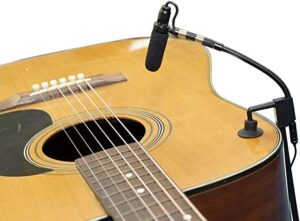
The AV-JEFES PMM19B-H4P-GT piano mic is a high-quality clip-on microphone designed for pianos. It features an XLR input and transmitter for wireless connectivity, which makes it easy to set up quickly. The microphone is unidirectional, which means it captures sound from the piano in a specific direction, minimizing background noise. It is also flexible, which allows for easy placement on the piano. Additionally, the microphone comes with a wireless receiver, which ensures the sound is transmitted reliably and without interference. The overall quality of the microphone is impressive, as it delivers clear and accurate sound without any distortion. The clip-on design makes it easy to attach and remove, without causing any damage to the piano. The AV-JEFES PMM19B-H4P-GT piano mic is an excellent choice for any pianist or recording artist looking for a wireless microphone with quick setup capabilities.
When it comes to recording live piano performances, having a quality microphone is essential. The AV-JEFES PMM19B-H4P-GT piano mic is one such option that promises to deliver exceptional sound quality. To ensure that you get the best possible results from this microphone, it’s important to consider its dimensions before installation.
The AV-JEFES PMM19B-H4P-GT piano mic comes in a compact size, with dimensions of 10 x 7.5 x 2.2 inches. This makes it easy to install and use without taking up too much space. The microphone is equipped with an XLR connector, which ensures stable and reliable connectivity.
One of the special features of the AV-JEFES PMM19B-H4P-GT piano mic is its clip, which allows for easy attachment to the piano. The microphone comes in a sleek black color and has a unidirectional polar pattern, which ensures that it captures sound only from the piano and not from other sources.
The AV-JEFES PMM19B-H4P-GT piano mic has an audio sensitivity of 48 dB and an impedance of 800 Ohm. It weighs just 2 ounces, making it easy to handle and move around as needed. Overall, this microphone is a great option for anyone looking to record piano performances with high-quality sound.
AV-JEFES PMM19B-H4P-GT Guitar Clip-On Musical Instrument Microphone First hand review
Video Source: Yu Samison
Pros:
- Compact size of 10 x 7.5 x 2.2 inches makes it easy to install and use
- XLR connector ensures stable and reliable connectivity
- Clip allows for easy attachment to the piano
- Unidirectional polar pattern captures sound only from the piano
- Audio sensitivity of 48 dB and impedance of 800 Ohm ensures high-quality sound.
CORE FEATURE
| Brand | AV-JEFES |
| Connectivity Technology | XLR |
| Connector Type | XLR Connector |
| Special Feature | Clip |
2) Earthworks PM40 piano mic

The Earthworks PM40 Piano Mic is a high-quality microphone designed specifically for piano recording. It is an instrument condenser microphone that is light weight and easy to set up. The PM40 is corded electric, making it easy to plug and play, and it has incredible gain, making it possible to capture even the quietest of notes with ease. The microphone also features stereo capabilities, which provides a full and balanced sound. The PM40 is not only easy to use but also incredibly durable, making it a great investment for anyone looking to capture the sound of their piano with high-quality recording equipment. Whether you’re a professional musician or just someone who wants to record their playing, the Earthworks PM40 is an excellent choice for capturing the sound of your piano.
The Earthworks PM40 Piano Mic is a stereo microphone designed to capture the essence of piano performances with incredible clarity and precision. Its low profile design and easy setup make it a popular choice for live performances, recording studios, and home use. The item weighs only 12 ounces and measures 46 x 6 x 3 inches, so it’s easy to handle and transport.
One of the most impressive features of the Earthworks PM40 Piano Mic is its incredible gain before feedback. This allows for optimal performance without the worry of feedback or distortion. Additionally, the mic is extremely lightweight, making it easy to handle and position on the piano without causing any strain or discomfort.
The Earthworks PM40 Piano Mic is a versatile microphone that is capable of capturing the natural sound of the piano. Its stereo design and low profile allow it to be placed in the perfect position to capture the entire range of the instrument without being obtrusive. This makes it a great choice for both live performances and recording sessions.
Earthworks Audio PM40 PianoMic Series Instrument Condenser Microphone
Video Source: purewaveaudio
Pros:
- The Earthworks PM40 Piano Mic has incredible gain before feedback, making it a reliable choice for live performances.
- Its lightweight design makes it easy to handle and position on the piano without causing any strain.
- The low profile of the mic allows it to be placed in the perfect position to capture the entire range of the instrument.
- The stereo design of the mic captures the natural sound of the piano.
- Easy setup of the mic allows for quick and hassle-free installation.
CORE FEATURE
| Item Weight | 12 ounces |
| Product Dimensions | 46 x 6 x 3 inches |
| Item model number | PM40 |
| Is Discontinued By Manufacturer | No |
| Color Name | Black |
3) Shure SM81-LC piano mic
![]()
The Shure SM81-LC is a high quality wired piano microphone that features a swivel adapter for optimal placement and a unidirectional condenser for accurate sound reproduction. With a frequency range of 20 Hz to 20 kHz, this microphone is capable of capturing the rich and nuanced tones of a piano, making it a great choice for live performance or recording. The 18 dB Attenuator-Switch Lock helps to minimize handling noise, while the XLR connector ensures a reliable and secure connection. Whether you’re a professional pianist or an audio engineer, the Shure SM81-LC is an excellent microphone that offers a balance of clarity and versatility, making it a valuable addition to any setup.
The Shure SM81-LC is a top-of-the-line piano microphone designed for professional recording and live performances. This microphone is built with high-quality materials and specifications to deliver exceptional sound quality and durability. To ensure accurate sound reproduction, dimensions must be taken into account during installation.
The product dimensions of the Shure SM81-LC are 11.9 x 6.1 x 3 inches, with an item weight of 1.6 pounds. The microphone features an XLR connector for easy compatibility with a variety of devices, including radios, amplifiers, and speakers. Additionally, this microphone requires one AAA battery to operate.
One of the standout features of the Shure SM81-LC is its low RF susceptibility, which ensures that the microphone is not affected by radio frequencies in the environment. The microphone also has selectable low-frequency response, which can be adjusted to achieve the desired sound quality.
Shure SM81-LC Cardioid Condenser Instrument Microphone for Guitar First hand review
Video Source: Front End Audio
Pros:
- Exceptional sound quality for professional recording and live performances
- Durable steel construction ensures longevity of the microphone
- Low RF susceptibility prevents interference from radio frequencies
- Selectable low-frequency response allows for customization of sound
- Compatible with a wide range of devices for versatile use.
CORE FEATURE
| Item Weight | 1.6 pounds |
| Product Dimensions | 11.9 x 6.1 x 3 inches |
| Domestic Shipping | Item can be shipped within U.S. |
| Item model number | SM81-LC |
| Batteries | 1 AAA batteries required. |
4) DPA 4099 piano mic
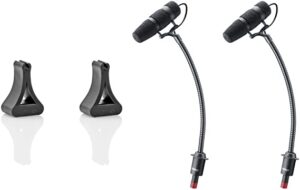
The DPA 4099 piano microphone is a high-quality, small-diaphragm stereo microphone with a unidirectional pickup pattern. Its XLR connector provides a reliable connection to audio equipment, ensuring clear sound quality. The microphone is also durable, making it suitable for frequent use in both studio and live performance settings. one standout feature of the DPA 4099 is its mounting clips. These allow for easy and secure attachment to the piano, reducing the risk of accidental movement or damage during performance. The small-diaphragm design of the microphone captures the intricate details of the piano’s sound, while the unidirectional pickup pattern ensures that other instruments or ambient noise do not interfere with the recording. overall, the DPA 4099 piano microphone is an excellent choice for pianists looking to capture high-quality stereo sound from their instrument. Its durable construction and reliable performance make it a valuable addition to any recording or performance setup.
The DPA 4099 Piano Mic is a small-sized microphone designed to capture the purest sound of a piano. With its XLR connector type and corded electric power source, this mic promises to deliver an exceptional audio quality that will leave you in awe. Its item weight of 15.8 ounces and product dimensions of 3.94 x 1.97 x 5.91 inches make it a lightweight and compact microphone that can easily be installed on your piano.
One of the essential features of the DPA 4099 Piano Mic is that dimensions must be taken before installation to ensure proper fit and optimal sound quality. The mic’s small size makes it easy to place it in any position on your piano without worrying about blocking your view or affecting your playing style. Additionally, its black color name gives it a sleek and elegant appearance that complements any piano’s design.
The DPA 4099 Piano Mic’s item model number is 4099-DC-1-101-P, and it is not discontinued by the manufacturer, making it a reliable and long-lasting investment. It is perfect for use in live performances, recording studios, or home settings, thanks to its exceptional audio quality and easy-to-use features.
DPA D:Vote CORE 4099 Stereo Instrument Microphone Set with Piano Mounting Clips First hand review
Video Source: DPA Microphones A/S
Pros:
- Exceptional audio quality that captures the purest sound of your piano.
- Lightweight and compact design that makes it easy to install.
- Sleek and elegant black color that complements any piano’s design.
- Reliable and long-lasting investment that is not discontinued by the manufacturer.
- Perfect for use in live performances, recording studios, or home settings.
CORE FEATURE
| Item Weight | 15.8 ounces |
| Product Dimensions | 3.94 x 1.97 x 5.91 inches |
| Item model number | 4099-DC-1-101-P |
| Is Discontinued By Manufacturer | No |
| Color Name | Black |
5) FIFINE PC PS5 piano mic
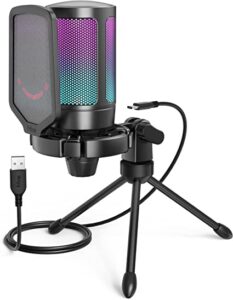
The FIFINE PC PS5 Piano Mic is a high quality condenser microphone that offers vivid voice recording for musicians and streamers. Its USB connectivity allows for easy plug-and-play setup, and the detachable design adds versatility to the microphone. The tripod stand provides stability during use, and the quick mute function adds an extra level of control for recording sessions. One of the standout features of this microphone is its ability to change RGB lighting, adding a unique touch to any setup. In conclusion, the FIFINE PC PS5 Piano Mic is a great choice for those looking for a reliable, high quality microphone that offers versatility and customization options.
The FIFINE AmpliGame is a powerful and versatile microphone designed specifically for gamers, content creators, and musicians who demand high-quality sound. This microphone is perfect for those who need a reliable and affordable solution that can deliver clear and accurate audio in any situation. The FIFINE AmpliGame microphone is packed with features that make it one of the best microphones in its class.
One of the most important aspects of any microphone is its size and dimensions. The FIFINE AmpliGame microphone is compact and lightweight, with product dimensions of 6.93 x 7.05 x 3.78 inches and an item weight of just 1.1 pounds. This makes it easy to handle and use, even for extended periods of time. Its unidirectional polar pattern also ensures that it captures sound from a single direction, minimizing background noise and ensuring that your voice is heard loud and clear.
The FIFINE AmpliGame microphone is incredibly easy to use and comes with a USB connector type for easy connectivity. It is compatible with a range of devices, including laptops, PS4, PS5, and personal computers. Its handy use and convenient installation make it perfect for anyone who needs a microphone that they can use on the go, without having to worry about complicated setup procedures.
In addition to its impressive specifications, the FIFINE AmpliGame microphone also comes with useful accessories that enhance its overall functionality. The microphone features gradient RGB lighting that adds a touch of style and flair to your gaming or streaming setup. It also has a quick mute button that allows you to quickly and easily mute the microphone when needed, ensuring that you don’t accidentally broadcast any unwanted background noise.
FIFINE Gaming USB Microphone for PC PS5, Condenser Mic with Quick Mute First hand review
Video Source: Medricito
Pros:
- The FIFINE AmpliGame microphone has a compact and lightweight design, making it easy to handle and use for extended periods of time.
- Its unidirectional polar pattern ensures that your voice is heard loud and clear, even in noisy environments.
- The microphone is incredibly easy to use and comes with a USB connector type for easy connectivity to a range of devices.
- The gradient RGB lighting and quick mute button add a touch of style and functionality to the microphone, making it perfect for gamers and content creators.
- Its useful accessories and convenient installation make it a versatile and reliable solution for anyone who needs a high-quality microphone.
CORE FEATURE
| Brand | FIFINE |
| Model Name | AmpliGame |
| Connectivity Technology | USB |
| Connector Type | USB |
| Compatible Devices | Laptop, PS4, PS5, Personal Computer |
6) Donner UA-22 piano mic
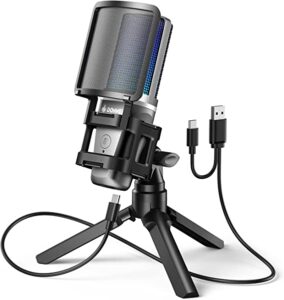
The Donner UA-22 Piano Mic is a high-quality microphone that boasts several noteworthy features. It is USB compatible, making it easy to connect to both MacOS and Windows computers for quick recording. The microphone is also unidirectional, ensuring that it captures only the desired sound source, making it ideal for vocal recording. The one-tap mute feature is a convenient addition, allowing users to quickly mute the microphone when not in use. The 3.5mm connector is a standard size, ensuring that the microphone is compatible with a wide range of devices. This corded electric microphone is ideal for those who are looking for a high-quality recording solution at an affordable price point. With its easy-to-use interface and high-quality sound, the Donner UA-22 Piano Mic is an excellent choice for anyone who wants to record vocals or musical instruments with clarity and precision.
Donner UA-22 Piano Mic: A Comprehensive Review
The Donner UA-22 Piano Mic is an impressive microphone that offers professional-grade sound quality for pianos, vocals, and other acoustic instruments. This microphone features a unidirectional polar pattern that helps reduce background noise and enhances the clarity of the sound. The Donner UA-22 Piano Mic is designed to connect via USB, making it compatible with laptops, gaming consoles, and PCs. Additionally, this microphone comes with a stand that allows for easy adjustment of the microphone’s height and angle.
Dimensions must be taken into consideration when purchasing the Donner UA-22 Piano Mic. This microphone weighs 1.09 pounds and has package dimensions of 8.7 x 4.76 x 3.31 inches. Its compact size makes it easy to transport and store, making it ideal for musicians who are always on the move.
The Donner UA-22 Piano Mic has several notable features that make it stand out from other microphones in its price range. The microphone’s plug-and-play feature means that it is easy to set up and use without any additional software or drivers. The Donner UA-22 Piano Mic also boasts a natural vocal reproduction feature that accurately captures the nuances of the human voice. Its one-tap mute button is another useful feature that allows for quick and easy muting of the microphone when necessary.
Donner USB Microphone, Condenser Cardioid Microphone for PC First hand review
Video Source: Obscure Mics
Pros:
- Plug-and-play feature for easy setup
- Natural vocal reproduction for accurate sound capture
- One-tap mute button for quick muting of the microphone
- Real-time monitor for immediate feedback on sound quality
- Comes with a stand for easy adjustment of height and angle.
CORE FEATURE
| Brand | Donner |
| Connectivity Technology | USB |
| Connector Type | USB, 3.5 mm Jack |
| Special Feature | Stand |
7) Bietrun piano mic
The Bietrun piano mic is a high-quality and portable microphone that is omnidirectional, making it perfect for capturing the full sound of a piano. It is also durable, which is important for a device that is likely to be moved around frequently. The cordless design makes it easy to use, and the rechargeable transmitter ensures that it is always ready to go when you need it. The Bietrun piano mic has a playtime of up to 6 hours, which is more than enough time for most performances or recording sessions. Finally, the 2.4G wireless technology means that you don’t have to worry about interference or other audio issues, ensuring that your recordings or performances sound clear and professional. Overall, the Bietrun piano mic is an excellent choice for anyone who needs a high-quality, portable, and reliable microphone for piano recording or performance.
The Bietrun Piano Mic is a top-quality wireless microphone that is designed to help musicians and performers capture every note with precision. This microphone is a product of the Bietrun brand and comes with the model name WXM33. The mic is specifically designed to work with Apple devices such as iPhones and iPads, making it a perfect choice for musicians who prefer to record their music using these devices. One of the key features of the Bietrun Piano Mic is its 2.4G connectivity technology, which ensures that it delivers a stable and reliable connection when in use.
To ensure that you get the best possible audio quality when using the Bietrun Piano Mic, it is important to take accurate dimensions when setting up the microphone. This ensures that the mic is positioned at the right distance from the sound source, which in turn helps to minimize any background noise that may interfere with the audio quality. The mic comes with an omnidirectional polar pattern, which means that it can capture sound from all directions. This feature makes it ideal for recording live performances or for use in large venues.
The Bietrun Piano Mic comes in a sleek and stylish black color, which makes it a perfect addition to any musician’s gear collection. It is made from high-quality plastic material, which ensures that it is durable and can withstand regular use. The mic is battery-powered, which means that you can use it for long periods without worrying about the battery life. Its package dimensions are 4.72 x 3.23 x 1.34 inches, while its item weight is 1.23 ounces, making it a lightweight and portable microphone that you can carry with you wherever you go.
Pros:
- The Bietrun Piano Mic is a plug-and-play microphone that is easy to set up and use, making it ideal for both amateur and professional musicians.
- Its 2.4G connectivity technology ensures that it delivers a stable and reliable connection when in use, which helps to minimize any disruptions during recordings or live performances.
- The mic is specifically designed to work with Apple devices such as iPhones and iPads, which makes it a perfect choice for musicians who prefer to use these devices for their recordings.
- Its omnidirectional polar pattern ensures that it can capture sound from all directions, making it ideal for use in large venues or for recording live performances.
- The Bietrun Piano Mic is perfect compatible with iPhone iPad, making it a great choice for anyone who wants a high-quality microphone that is specifically designed for use with these devices.
CORE FEATURE
| Brand | Bietrun |
| Model Name | WXM33 |
| Connectivity Technology | 2.4G |
| Connector Type | Lightning |
| Color | Black |
Best piano mic 2023-Complete Buying Guide
If you’re looking for the best microphone for recording a piano in 2023, this guide is for you. With so many mics and mic technologies on the market, it can be challenging to determine the best mic for your specific needs. In this guide, we’ll discuss all of the factors you need to consider when selecting a microphone that will optimize your recordings and get them sounding their best. We’ll provide recommendations on mics that have proven themselves to be of superior quality as well as which type of microphone will best suit your needs depending on the type of recordings and pianos you are working with.
Whether your recordings involve grand pianos, upright pianos in acoustically treated studios, or just digital synthesizers at home, this guide covers all the necessary information and considerations you need in order to choose a suitable mic. So let’s get started!
Importance of having a good microphone for piano recording
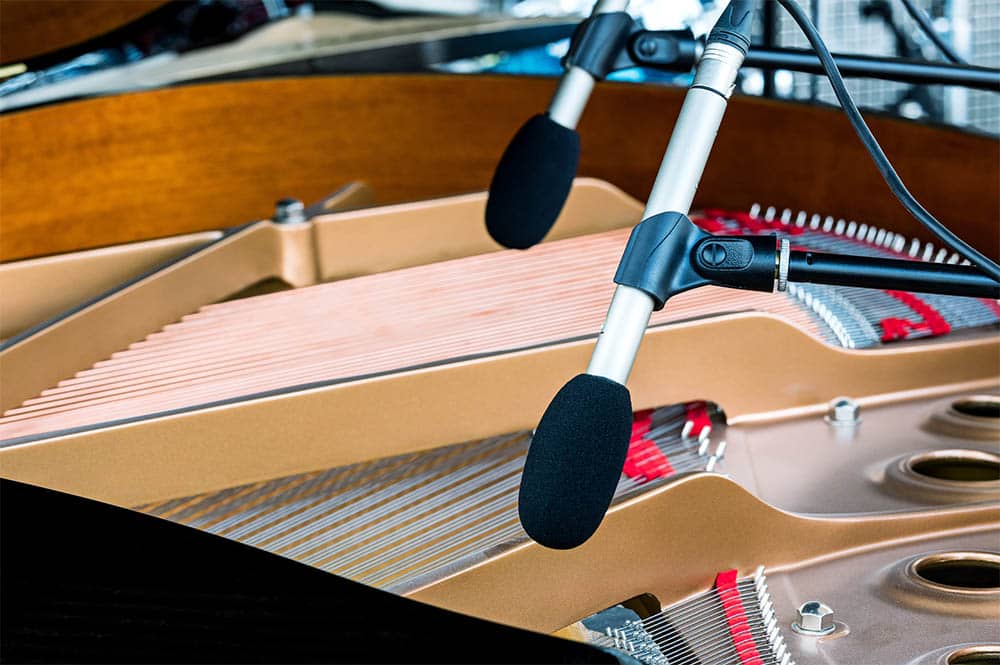
Photo Source: musicalhow.com
A good microphone is essential to capturing a great sound when recording a piano. Whether you’re in a studio or home-recording, having the right mic and settings can make the difference between a good recording and outstanding one. Professional studio engineers know all the nuances and use highly sensitive mics to capture complex sounds with maximum clarity.
When choosing a microphone for piano recording, there are certain criteria that should be taken into consideration:
- Size of the room determines what type of microphone set-up you will need (omni-directional for room with hard walls or figure-8 for softer reflections like walls with curtains).
- The quality of sound desired (natural, bright and clean or dark and warm) will determine frequency response selection, as well as how much proximity effect you want.
- Your choice of microphone preamps, as well as other equipment in your signal chain also has an effect on overall outcome.
Having the right mic is only half the battle though; proper placement can make all the difference in achieving desired results. Special attention should be paid to:
- Distance from source (close vs distant)
- Vertical alignment angle (on/off axis)
- Horizontal angle – distance from central player’s key production direction (cardioid response) etc.
A Web search can provide much more detail than this brief summary regarding perfect placement depending on application desired – if important aspect ratio and full dynamic range playback is goal then realistic experimentation might be indicated.
Ultimately, choosing an appropriate microphone for piano recording involves much more than selecting best brand / model given budget constraints; it involves selected characteristics and proper placement meticulously tailored to attain precise results desired from project at hand!
Overview of the best piano mics in 2023

Photo Source: shoph8.top
Piano mics come in a wide range of shapes, sizes, and applications, so it is important to understand the best piano mics of 2023 before spending your money. As with all sound reinforcement products, quality should be the primary deciding factor in selecting a mic for your piano; ideally you would want a mic that can handle a variety of tones, including low end and high end frequencies.
The Shure SM7B, Neumann U87 Ai (VINTAGE), R0DE NT2-A (Classic II), Audio Technica AT2035, AKG C414 XLS/XLII are generally considered the industry standard microphone for close-proximity miking of pianos. These top-of-the-line mics offer excellent sound reproduction and can handle a wide frequency response range. They all provide excellent durability with features like extended frequency responses and rugged construction.
For those on a budget or for use in smaller venues where there is less space to work within, the MXL V77 SDC & MXL 603S Pencil Cardioid Condensers are good choices as they do not sacrifice much in terms of sound quality while remaining affordable. Another budget option worth considering is the Behringer B1 Large Diaphragm Studio Condenser which offers good value at an affordable price point. Another great budget choice is the sE Electronics X1 T Studio Condenser Microphone which offers great sounding results at an even lower price point than its competitors.
Overall, regardless of budget or preference when selecting piano mics there are several great choices out there to choose from that will best fit your needs and desired result.
Factors to Consider when Choosing a Piano Mic
Before settling on a particular mic for recording or amplifying your piano, there are certain factors you should take into account. These include the size, pickup pattern, frequency response, sound quality, and cost.
- Size: Piano mics come in various shapes and sizes. You’ll want to make sure that the mic is small enough to be easily moved around so it can capture all of the nuances of your piano.
- Pickup Pattern: Your choice of pickup pattern will depend on both the type of music you will be recording and playing back as well as where it will be placed during performance. Different microphones have different pickup patterns; some narrow in order to focus on particular instruments while others capture a wider range of sound.
- Frequency Response: The frequency response of a microphone is important because it determines which frequencies will be picked up and amplified by the microphone. Generally speaking, a wider frequency response makes for better signal reproduction from an acoustic instrument like a piano.
- Sound Quality: Not all microphones are created equal; some are built with higher quality components than others resulting in different levels of signal clarity and signal-to-noise ratios.
- Cost: Lastly – but certainly not least – cost is an important consideration when deciding on a microphone for your piano needs. While some mics can range into hundreds or even thousands of dollars, there are also some reasonably priced models available which could still adequately fulfill your needs without breaking budget constraints.
Directionality
The four major mic types divided by directionality are omnidirectional, cardioid, super-cardioid, and bidirectional mics. Every mic has its pros and cons when it comes to recording a piano.
Omnidirectional mics are the most versatile type of microphones used for capturing sound from many directions. They offer a neutral response pattern that provides a wide panoramic pickup of ambient sounds from the instrument’s surrounding environment, which can be beneficial if you want to capture the subtle nuances of an acoustic setting or aspect of an audio source. However, this attribute also makes it more prone to picking up unwanted noise and reverberation in comparison to directional mics.
Cardoid mics have a heart-shaped pickup pattern that is sensitive mainly to sound coming in from directly in front while at the same time rejecting background noise coming from other angles. This type is great for soloing instruments such as pianos since they tend to pick up only the direct sound while reducing unwanted background elements like room reflections or other instrument crossovers that could interfere with the recording.
Super-cardioids have a more focused version of the cardioid pattern and provide excellent isolation (especially on side rejection) but at possibly greater cost than traditional cardiods due to higher design complexity, i.e., requiring multiple capsule elements instead of just one for traditional cardiods. This type is best suited for capturing intimate detail from delicate parts without sacrificing tone quality generated by strong basses or offbeats found often in drums or string instruments recording sessions accompanying piano pieces separately or together with orchestra members taking part within them simultaneously when all microphones involved are required equally on either purpose applied respectively within different takes/multiple takes afterwards when post production is taken into consideration right away during audio editing stage definitely.
Frequency Response
Frequency response refers to the range of frequencies a mic can detect. You’ll want a mic with good all-round frequency response for recording acoustic piano, as the instrument covers just about every frequency range. Make sure you look for mics with a wide enough frequency range for the job, anywhere from about 20 Hz to 15 kHz should do it.
Of course, the specifics of your mic’s frequency response will differ depending on its size and type. Condenser mics often have better and wider frequency responses than their dynamic counterparts, and small-diaphragm condensers provide more extended highs than bigger models. It pays to do some research into what works best when choosing your mic—regularly take note of customer reviews and feedback too!
Sensitivity
The sensitivity rating indicates how much level (in decibels) a microphone can capture with a given sound pressure level. Simply put, it’s the microphone’s ability to detect quieter noises at lower sound levels.
The higher the sensitivity rating, the more sensitive the mic will be to subtle sounds like those in classical music. So if you’re playing an extremely quiet piece of music, then look for mics that have high sensitivity ratings – usually around 14 dB or more – to ensure your quieter tones come through crystal clear. Most modern microphones feature very high sensitivities, enabling them to capture even the quietest sounds with exceptional clarity and dynamic range.
III. Top Piano Mics of 2023
This section will provide an overview of the top 5 piano mics of 2023. Each mic has its own set of features, and this section will help you identify which model is the best for your needs.
- Rode M5 – This cardioid microphone offers excellent clarity and presence in recordings, with high SPL capabilities and a low-cut filter switch for optimizing the sound. It is well-suited for both grand pianos as well as upright models.
- Neumann KM 184 – The KM 184 is designed to pick up subtle nuances of sound with its highly sensitive transducer. It comes with a special shock mount that reduces handling noise and vibrations to preserve sound quality.
- AKG C 414XLII – This microphone provides a warm and natural sound signature, making it ideal for classical performances as well as pop music recordings in an indoor studio setting.
- AKG Perception 420 – With its large diaphragm capsule that provides crystal clear high definition audio, this mic is best suited for solo performance artists looking to get the highest quality portable recordings in live settings with minimal noise interference from outside sources like PA systems or Background chatter.
- Audix ADX-51 – This mic delivers an articulate sound with clarity at all frequencies, ideal for recording vocals as well as electric instruments like piano and guitar in noisy environments where traditional microphones might struggle to capture accurate audio signals without distortion or feedback issues cropping up along the way.
Shure Beta 181/O
The Shure Beta 181/O is one of the top choices for best piano mic in 2023. It’s a particularly great choice for capturing acoustic piano sounds, known for its natural and precise sound reproduction. Especially when paired with an all-important preamp, you can achieve true and rich tones – superbly representing the individual strings without creating feedback or excessive sibilance arising.
The cardioid pick-up pattern gives you greater accuracy on which sources to capture whilst avoiding interfering noise from another source. How the Beta 181/O picks up sound means it can effectively minimize external noise and reverberation, while still retaining a focused tone throughout the entire piano range of sound.
- Its proximity effect compensation switch will also serve to provide extra clarity in far away miking situations, like when processing multiple tracks of piano at once.
- Its shock mount design as well as attenuation switch will allow for optimized low frequencies even in close miking situations.
Audio-Technica Pro 37
The Audio-Technica Pro 37 is a great mic at an affordable price. This cardioid condenser mic is perfect for piano recording, as it produces a clear, natural sound that won’t be too harsh or too muddy. It provides more than enough detail and clarity to capture the distinct nuances of each note without sacrificing the overall tonal balance of the instrument.
It also features a low noise floor and a wide dynamic range, making it suitable for capturing instruments in both studio and live settings. It also has switchable low frequency roll-off and 10dB attenuation switches, making it easy to adjust your levels during recording.
Neumann U87 Ai
The Neumann U87 Ai is a high fidelity microphont that has been widely used in the recording industry since its release in 1967. Its popularity is due to its inviting presence and clarity, particularly when working with acoustic instruments, orchestras, and vocalists due to its highly accurate frequency response curve.
It offers two switchable polar patterns to allow you to capture the best representation of sound based on your needs – cardioid or omnidirectional. The different patterns are great while recording piano pieces by allowing one mic to be positioned more towards the hammers, strings and keys for a detailed up-close sound. At the same time another mic can be held further away for an airy/wide sound of all 88 keys at once!
The U87 also comes with a built-in low-cut filter that gives it the capability to reject unwanted low-end from other sources like room reflections which reduces background noise from getting into your recordings. This makes it an ideal choice for those who want clean and clear piano recordings without having to add additional processing or EQing post production.
Conclusion
A piano microphone provides the means to record a piano such as an acoustic grand or upright, or use it live in a performance. There is no single ‘best’ microphone for the piano, as each has its own unique combinations of features and sonic qualities.
You may be looking for an affordable, general-purpose mic that can capture subtle nuances of the keys during a solo performance, or seeking a higher-quality mic that captures the body sound of a grand piano in an ensemble recording.
Ultimately, together with your budget and intended uses, your requirements should guide you towards making an educated decision about which model is best suited for your needs. Keep in mind that no matter which mic you choose; devoted practice and proper technique are both essential for getting great results from your recordings or performances.
FAQ’s
Why buy a condenser microphone?
One of the main reasons to buy a condenser microphone is for their high level of sensitivity, which is useful for recording detailed, nuanced audio signals. They are also often favored for their wide frequency response and ability to capture a high level of detail in the sound they pick up.
What mic did John Lennon use?
John Lennon was known to have used a Neumann U67 microphone during the recording of many of The Beatles’ albums.
Which mic is best for recording songs?
The best microphone for recording songs will depend on a variety of factors, including the type of music being recorded, the intended use of the recording, and the individual preferences of the recording engineer or musician. Some popular options for recording songs include large-diaphragm condenser microphones, such as the Neumann U87 or the Shure SM7B, as well as dynamic microphones, such as the Shure SM7B or the Electro-Voice RE20.
Which mic is used by professional singers?
Many professional singers use condenser microphones, such as the Neumann U87 or the AKG C214, for their clarity and high level of detail. Dynamic microphones, such as the Shure SM7B or the Electro-Voice RE20, are also sometimes used by professional singers, particularly in live performance settings.
What mic does paul McCartney use?
Paul McCartney has used a variety of microphones throughout his career, including the Shure SM58 and the AKG D12.
How do you play MIDI piano through mic?
To play MIDI piano through a microphone, you will need a MIDI controller and an audio interface that allows you to connect the controller to your computer. You will then need to use software, such as a digital audio workstation (DAW), to play the MIDI files and route the audio output to your microphone.
How can I play high quality music through my mic?
To play high-quality music through a microphone, you will need to use a high-quality audio source and microphone, as well as a clean and noise-free signal path. This may involve using an audio interface and mixing software to route the audio signal and adjust levels and other parameters.
How do you record yourself playing the piano?
To record yourself playing the piano, you will need a microphone and an audio interface that allows you to connect the microphone to your computer. You may also need to use a stand or tripod to hold the microphone in place. Once you have the equipment set up, you can use a digital audio workstation (DAW) to record the audio signal from the microphone.
How do you mic a jazz piano?
To mic a jazz piano, it is often best to use one or more directional microphones, such as a cardioid or hypercardioid pattern, to focus on the sound of the piano and minimize any unwanted ambient noise. You may also consider using multiple microphones to capture different elements of the sound, such as a close mic for the sound of the hammers and strings, and a room mic to capture the overall sound of the piano in the space.
Can you mic a piano with SM57?
Yes, it is possible to mic a piano with an SM57 microphone, although it may not be the best choice for all situations. The SM57 is a versatile microphone that is often used in live performance settings, but it may not provide the level of detail and clarity that is desired for recording piano in a studio setting. In general, it is best to experiment with different microphone options to find the one that works best for your specific needs and setup.


